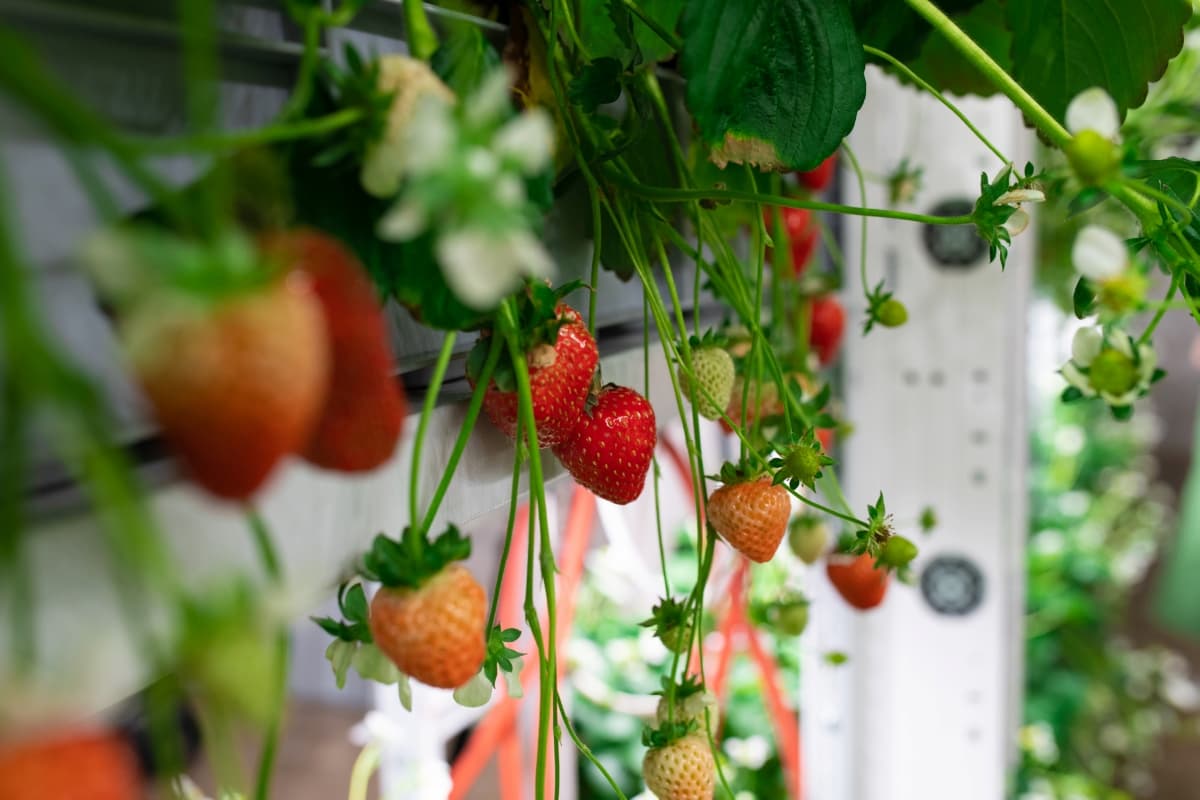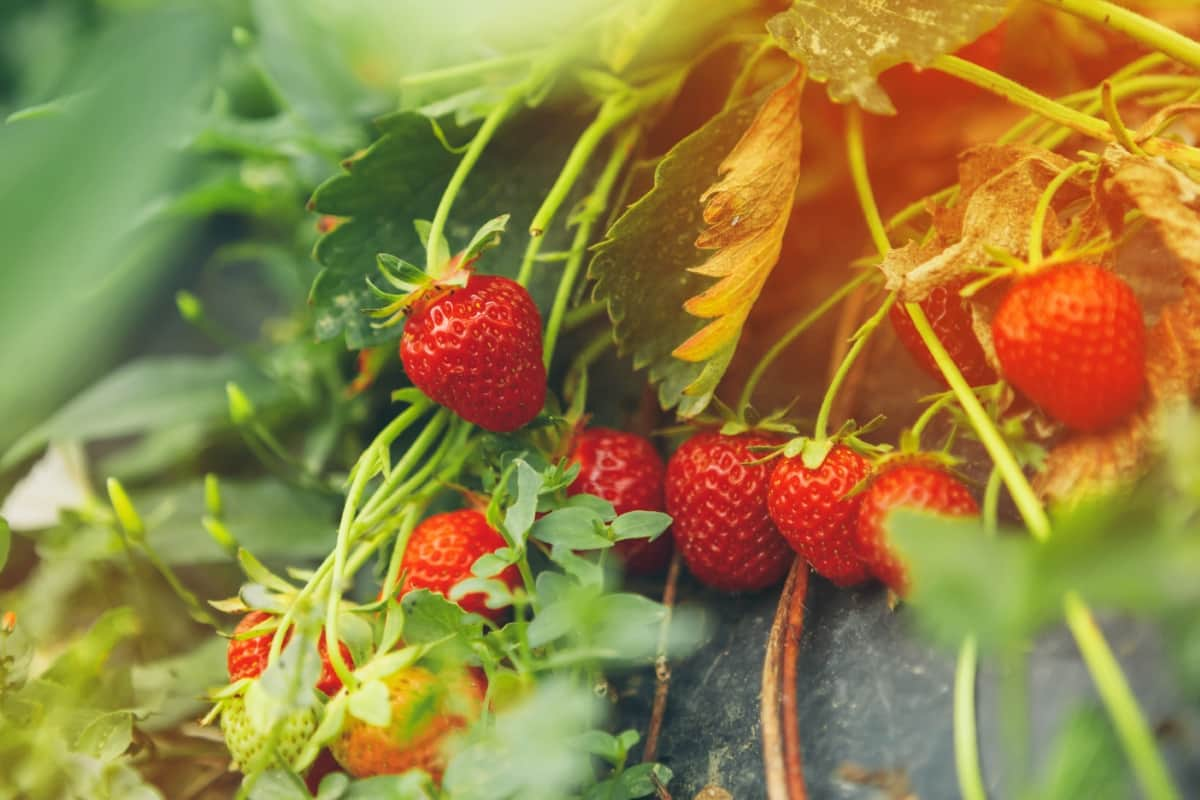Gardening, with its promise of healthy produce and therapeutic benefits, often presents challenges that need a keen eye and comprehensive knowledge to overcome. One challenge strawberry gardeners frequently encounter is the perplexing spectacle of red leaves on their plants. Notably, this color change is a vital clue to potential problems within the plant system.

Although a small number of red leaves can be part of the plant’s natural life cycle, excessive redness, especially on strawberry leaves turning red at the edges, can be a sign of something amiss. This article will explore the causes, remedies, and ways to fix this widespread issue. We will also focus on the issue of strawberry leaves turning red in winter and discuss an overwatered strawberry plant’s effects.
Red Leaves on Strawberry Plant
Understanding the Causes
Environmental Factors: Environmental stress is a common cause of strawberry leaves turning red at the edges. These include extreme temperatures, sudden frosts, or even excessive sunlight. In particular, strawberry leaves turning red in winter is a common sight due to the cold stress the plants endure in the colder months.
Nutrient Deficiencies: The strawberry plant might suffer from nutrient deficiencies, particularly a lack of nitrogen. Nitrogen is vital for making chlorophyll, the pigment that gives leaves their green hue. The green fades if a plant lacks nitrogen, and a reddish hue may take over.
Pests and Diseases: Various pests like spider mites and diseases like leaf scorch or leaf blight can cause strawberry leaves to turn red. These biological stresses can compromise the plant’s health and change leaf color.
Watering Issues: An overwatered strawberry plant can also show red leaves as a sign of distress. Overwatering leads to waterlogged soil, which hampers root respiration, leading to plant stress and discoloration of leaves.
Identifying the Remedies
Addressing Environmental Stress: If environmental stress is the cause, the remedy would be to provide a more favorable environment for the plant. For instance, during harsh winters, cover the strawberry plants with straw or use a cold frame to shield them from extreme temperatures. If sunlight is excessive, consider using a shade cloth during the peak sun hours.
Correcting Nutrient Deficiencies: To counteract nutrient deficiencies, particularly nitrogen, consider using a balanced fertilizer that offers a wide range of essential nutrients. Regular soil testing will help ensure your strawberries receive what they need.
Pest and Disease Control: For pests and diseases, remedies might include using organic or chemical pesticides, depending on the severity. Regular monitoring of the plants can help in early detection and prevention of these biological threats.
Watering Practices: In the case of an overwatered strawberry plant, the remedy lies in improving watering practices. Ensure the plant has well-draining soil and that water does not sit around the roots. Maintaining a consistent watering schedule will also prevent both over and underwatering.
In case you missed it: Hydroponic Strawberry Farming in a Greenhouse: Key Rules to Start from Scratch

How to Fix Red Leaves on Strawberry Plants
Mitigating Environmental Stress: To fix environmental stress-related issues, consider relocating your strawberries if the current location is consistently too hot, cold, or exposed to harsh weather conditions. Strategic planting can ensure the plants get the right amount of sunlight and protection from extreme weather.
For strawberry leaves turning red in winter, consider a winterizing regimen, which includes mulching your strawberry beds with straw to protect them from freezing temperatures. Remember, consistency is key to maintaining a healthy environment for your strawberries.
Addressing Nutrient Deficiencies: Start a regular fertilizing regimen if your strawberries suffer from nutrient deficiencies. Use a balanced, slow-release fertilizer that is designed for fruits or vegetables. Follow the recommended rates and frequencies on the fertilizer package, or seek advice from your local extension service. Fixing nutrient issues is not an overnight process, but with time, your strawberry plants should recover and display their characteristic lush green leaves.
Controlling Pests and Diseases: For pests and diseases, fix the issue by adopting a comprehensive, integrated pest management (IPM) strategy. This includes regular inspection of plants, identifying the pests or diseases, applying the appropriate treatment, and monitoring the plants for any changes. You may need to remove and destroy affected plants for severe infestations to prevent the problem from spreading.
Improving Watering Practices: An overwatered strawberry plant can be fixed by adjusting your watering schedule. Keep the soil moist but not waterlogged. Drip irrigation systems deliver water directly to plant roots, minimizing overwatering risks. Improve soil drainage by adding organic matter or sand, which can help excess water escape, preventing waterlogging.
Regular Monitoring and Maintenance: Lastly, a crucial step in ensuring the health of your strawberry plants is the practice of regular monitoring and maintenance. This involves routinely checking your plants for signs of stress or disease, pruning off any dead or diseased leaves, and taking swift action at the first signs of trouble.
This may involve adjusting the plant’s location, altering your watering schedule, applying the correct fertilizers, or implementing pest control measures. Regular monitoring enables timely identification and treatment of possible problems, preventing their progression into serious issues. Such practices significantly maintain the plant’s overall health and ensure a bountiful strawberry harvest.
Adapting to Seasonal Changes: An essential step in managing strawberry plant health is to adapt your gardening practices to the changing seasons. Like many plants, strawberries have different needs depending on the time of year. For instance, they might require more frequent watering and feeding during the growing season.
In case you missed it: Planting Strawberry Seeds in Pots: Step-By-Step Process for Beginners

On the other hand, as winter approaches, focus on protecting your strawberry plants from harsh conditions. This might involve reducing watering, applying mulch for insulation, and using protective covers for severe weather. Understanding these seasonal requirements and adapting your care routine can significantly improve your strawberry plants’ health and productivity.
Conclusion
Red leaves on a strawberry plant can stem from various causes, each demanding a different remedy and strategy to fix it. While it may be natural for some strawberry leaves to turn red, especially during the fall or under stress, an abundance of red leaves often indicates a problem. By recognizing the potential causes, such as environmental stress, nutrient deficiencies, pests, and diseases, or an overwatered strawberry plant, appropriate measures can be taken to remedy the situation.
These might include environmental adjustments, nutrient supplements, implementing pest control measures, or fine-tuning watering practices. Armed with this knowledge, we hope you feel better equipped to face this challenge and ensure your strawberries stay as healthy and productive as possible.
- Feed Your Flock for Less: Top 10 Tips to Save on Chicken Feed
- Ultimate Guide to Ossabaw Island Hog: Breeding, Raising, Diet, and Care
- Hatching Answers: The Top 10 Reasons Your Chickens Aren’t Laying Eggs
- Eggs and Economics: Breaking Down the Cost of Raising Backyard Chickens
- Defend Your Greens: Proven Methods to Keep Iguanas Out of Your Garden
- Ultimate Guide to Cinnamon Queen Chicken: A Comprehensive Guide for Beginners
- Ultimate Guide to California Tan Chicken: Breeding, Raising, Diet, Egg-Production and Care
- Ultimate Guide to Marsh Daisy Chicken: Breeding, Raising, Diet, and Care
- 10 Types of Chicken Farming Businesses You Can Start for Profits